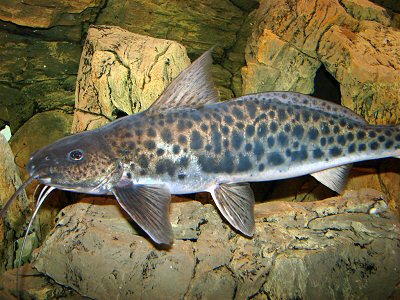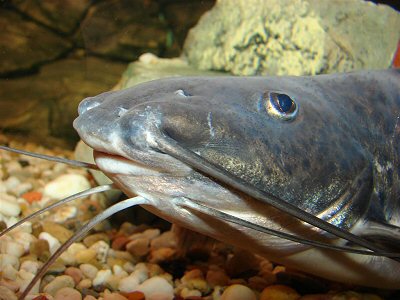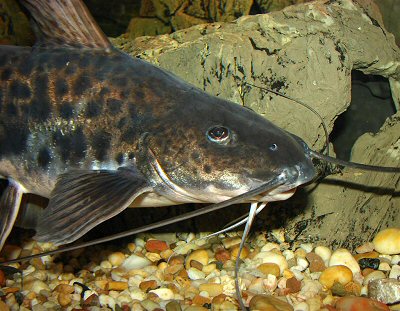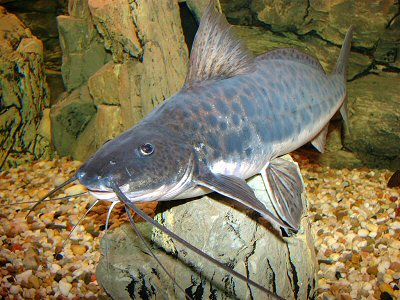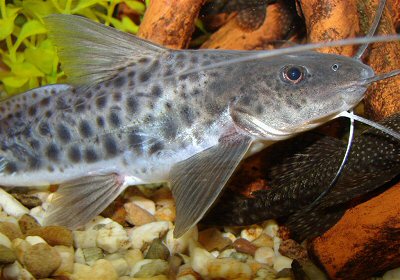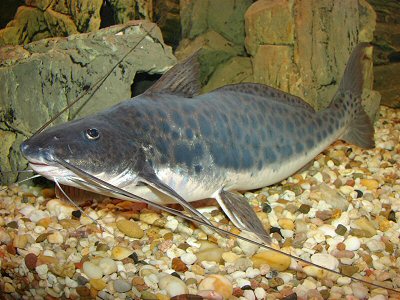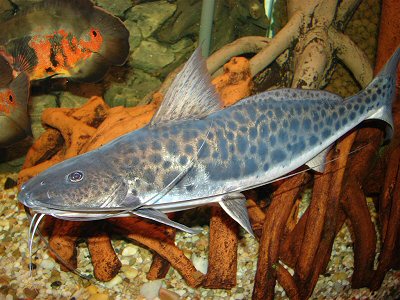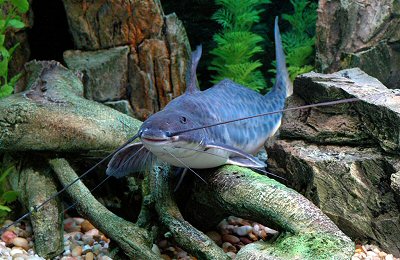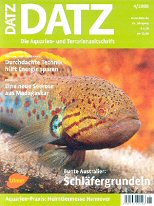SCOTCAT.COM
your internet guide to all things catfish
| A "shark" in the fresh water aquarium: Calophysus macropterus |
by Wolfgang Ros and Jacob Schmidt |
C. macropterus, doing laps of the aquarium in expectation of food
Some aquarists know this phenomenon: The keeping of a certain fish species binds one in such a way that one turns to it again after many years of occupation with other ornamental fish. The catfish species described here we already had kept in the middle of the 1980s, and after approximately two decades we returned to it again to its keeping, whereby the procurement of one specimen brought us together and led to an active exchange of experiences. C. macropterus, doing laps of the aquarium in expectation of food. Species
description In its body form and patterning C. macropterus reminds us of two further catfish species of South America: Aguarunichthys torosus (German: Stierantennenwels), which is however spotted up to the underneath of the belly, and the even more rarely introduced Platynematichthys notatus, whose impressive extended dorsal fin ray makes it unmistakable. Also C. macropterus is not often seen in the trade, however it is now and is offered by specialist dealers, who specialise in the import of predatory species. Particularly young animals are to be had with approximately 40 euro, which is comparatively low priced. Keeping
In its natural habitat C. macropterus will get to a maximum length of 60 centimetres, in the aquarium it reaches 40 to 50 centimetres. Since it is no ambush predator but a more active species, tanks that are to be used should, if at all possible, be not less than two meters in length and a minimum depth of 70, or better, 80 centimetres. This catfish feels well if it has a sufficient swimming area left to it. In the rear of the aquarium, well secured stone structures or durable solitary plants should be present and roots or large stones as resting places, then a hiding place, into which the animal can retire itself completely, is not necessary. Calophysus macropterus adult in profile - with its barbles this catfish can smell excellently. Aquarium
observations
Referring to occasions as with feeding, in addition during vibration, this catfish is very mobile and speedy. As soon as the keeper approaches the aquarium, C. macropterus notices him or here, because even over a certain distance it begins to relate to its keeper by means of its very long upper barbles. The hungrier it is the jerkier and in addition livelier it becomes and shows this by swimming up and down the front glass. As soon as food was given the predator is in action and looks for it. At this sight of this visitors automatically draw parallels to the swimming movements with sharks, particularly if C. macropterus also puts up the dorsal fin completely, its slim elegant body reminds them of these large sea predators. First slowly, then getting faster and as soon as the food morsel was located, snapping it fast, showing its hunting behaviour. The high-sensitive barbles leads the animal to the piece of trout lying on the ground. Even for the viewer it is impressive: First finding the prey in principle takes place not by means of visual contact, but owing to the forward placed barbles it guides the animal even with weak smelling traces, and as also in nature in cloudy water, still leading to the food. The species is not choosey with the selection of its food and besides live foods such as earth worms it also gladly takes shrimps or fish filets, even food sticks or Forelli pellets are eaten. In nature these flexible predators are even predominantly nourishing themselves on carrion, therefore comes the English description of "Vulture Catfish". So it is not surprising that the muzzle of C. macropterus with its strong jaws and the very special teeth is able to rip out, even with very large food portions, unproblematic bite-sized pieces. If the animal is full, it rests on its favourite place, but even this phase is interrupted in irregular fashion and swims in one or two rounds through the tank, before it rests itself back there again . As well as we never see our specimen digging, so plants will not be damaged, however they should be firmly fixed in the bottom, because otherwise with the occasionally hectic movements of the catfish, they will be uprooted.
C. macropterus can be associated with congeners. For this purpose one lets them grow up together, best with two or three young animals. They are predatory catfish with fast growth, but although somewhat dependent on the aquarium size too, 10 to 15 centimetres long specimens grow more than the double of there own length in the first year of there keeping. About five years old, specimen of 45 cm in length and a weight of over 1 kg, resting on its favourite place.
Among one another this species even looks for body contact: Two young animals of same size, which we socialised with one another, often would lie together, until one starts abruptly and after a short excursion in the tank associates itself again with the other one. Every now and then they do some rounds together and then push themselves mutually together. Possibly the social behaviour shown here is already conditioned as sex specific. There are still no consolidated findings to possibly present any sexual differences, probably however with adult animals the males are slimmer. Altogether C. macropterus is somewhat more active when socialising with congeners than during single keeping. Young
specimen of 13 cm in length, whose colouring is brighter
than with older animals.
If the catfish cannot devour the prey fish at one time it will, and also here the parallels to the sea predator are unmistakable, be made disabled by a bite in the tail fin or a separation of the complete tail. Attracted by the smell and the death fight of the prey the possible species companions also take part, then the rest of the prey is fed by all in a true devour orgy. The first attack is already done so fast that an intervention of the keeper usually comes too late. The upper barbles of Calophysus macropterus are very long and reach back to the end of the caudal fin.
Such losses are the reason this species has suffered such a reputation, however they can be avoided in the tank if sufficient food is always given, but understanding automatically that this happens with the keeping of predatory species. In all other respects associated fish are to be selected carefully. Central and South American cichlids and above all the well fortified species are possible, in addition large L-catfish and with appropriate tank sized fresh water rays of the genus Potamotrygon. Opposite them, C. macropterus behaves completely peacefully, even in the long term. C. macropterus can be associated well with larger cichlids like here in the background with Oscars (Astronotus ocellatus).
All in all C. nigricaudus from the colouring is more attractive. It does not grow as large as its genus comrade but adjusts this however by its aggressive approach to its keeper and potential socialised fishes. So who is looking after the mysterious and incalculable and also fascinating should decide for this species. Who however enjoys a calm, to some extent reliable giant overeater, which is sensitive also towards heaters and pumps, C. apurensis is to be recommended. Conclusion: When reasonable planning even socialization is possible. Under aquaristic aspects this interesting catfish to this day is undervalued and could be more frequently seen in big home aquariums to convince astonished visitors of its attractiveness. An eye
catcher in the big aquarium. With this specimen the
bluish colouring is particularly strongly pronounced.
Our thanks apply here for the Datz editorship and their editor-in-chief, Rainer Stawikowski, who gave us kind permission to publish this article on ScotCat. © Copyright text and photos, Datz, published here with permission. |
If you would like to contribute an article, please e-mail me. You will of course be credited for your work.
If you would like to donate any denomination of money to the site just click the above link button. All proceeds will go to running the site and hopefully to keep it going for a few years yet.
Print or e-mail this article below
